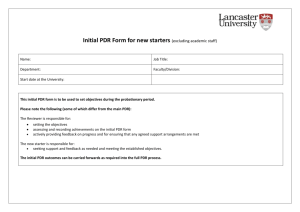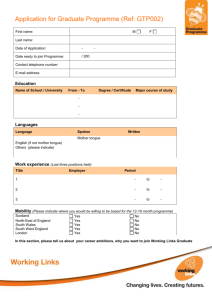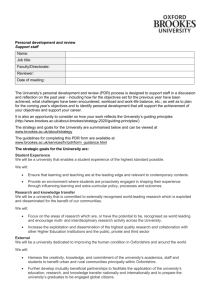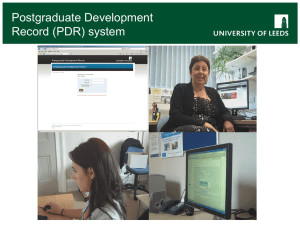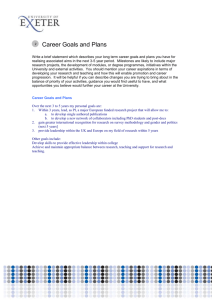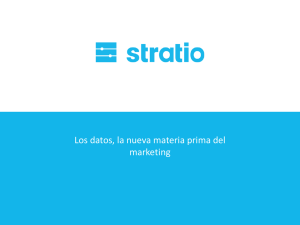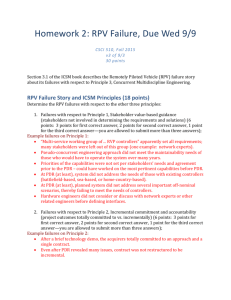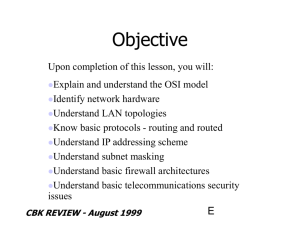CBK/PDR Workshop for Directors and Home-based
advertisement
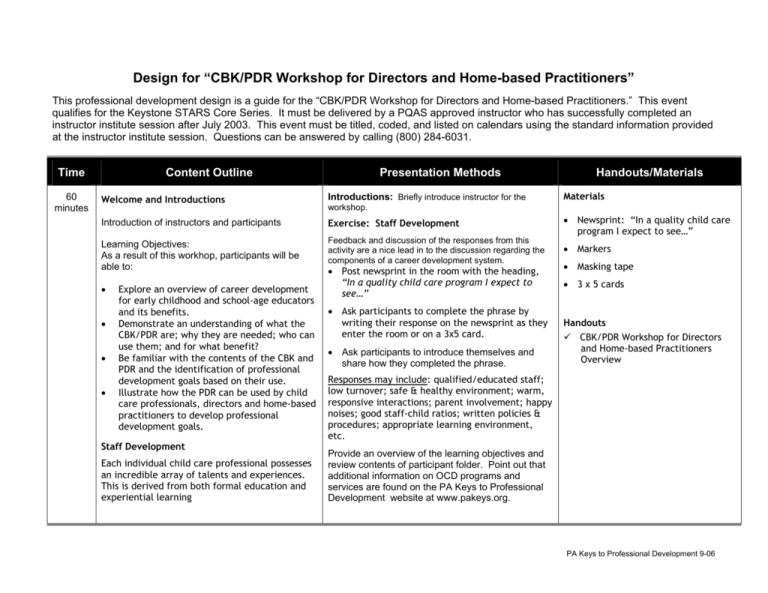
Design for “CBK/PDR Workshop for Directors and Home-based Practitioners” This professional development design is a guide for the “CBK/PDR Workshop for Directors and Home-based Practitioners.” This event qualifies for the Keystone STARS Core Series. It must be delivered by a PQAS approved instructor who has successfully completed an instructor institute session after July 2003. This event must be titled, coded, and listed on calendars using the standard information provided at the instructor institute session. Questions can be answered by calling (800) 284-6031. Time 60 minutes Content Outline Presentation Methods Handouts/Materials Materials Welcome and Introductions Introductions: Briefly introduce instructor for the Introduction of instructors and participants Exercise: Staff Development • Newsprint: “In a quality child care program I expect to see…” Learning Objectives: As a result of this workhop, participants will be able to: Feedback and discussion of the responses from this activity are a nice lead in to the discussion regarding the components of a career development system. • Markers • • • • Explore an overview of career development for early childhood and school-age educators and its benefits. Demonstrate an understanding of what the CBK/PDR are; why they are needed; who can use them; and for what benefit? Be familiar with the contents of the CBK and PDR and the identification of professional development goals based on their use. Illustrate how the PDR can be used by child care professionals, directors and home-based practitioners to develop professional development goals. Staff Development Each individual child care professional possesses an incredible array of talents and experiences. This is derived from both formal education and experiential learning workshop. • Post newsprint in the room with the heading, “In a quality child care program I expect to see…” • Ask participants to complete the phrase by writing their response on the newsprint as they enter the room or on a 3x5 card. • Ask participants to introduce themselves and share how they completed the phrase. • Masking tape • 3 x 5 cards Handouts 9 CBK/PDR Workshop for Directors and Home-based Practitioners Overview Responses may include: qualified/educated staff; low turnover; safe & healthy environment; warm, responsive interactions; parent involvement; happy noises; good staff-child ratios; written policies & procedures; appropriate learning environment, etc. Provide an overview of the learning objectives and review contents of participant folder. Point out that additional information on OCD programs and services are found on the PA Keys to Professional Development website at www.pakeys.org. PA Keys to Professional Development 9-06 Group Resume Exercise: Group Resume Materials The group resume may include information from the Professional Development Record such as: • Divide participants into groups of at least five members 9 Employment History 9 Total # yrs in the field (list one number for • Tell the group that everyone is an incredible array of talents and experiences • Markers • Newsprint: List categories found on a resume the whole group) 9 Educational Degrees Certifications, Awards, (Fitness, Academic, Punctuality, Attendance, etc.) 9 Professional activities (i.e. committees, readings), professional organization membership, publications (article, newsletters, etc.) 9 Prior and Ongoing Professional Development (list last 3 events attended) • Suggest that one way to identify and publicize the group’s resources is to compose a group resume. (You might want to suggest a job or contract on which they are bidding.) • Give the group markers and newsprint to display their resume. It should include any data that sells the group as a whole, such as, hobbies, talents, travel, major accomplishments. • Each group shares their resume with the larger group. • Use this time to acknowledge the talent and experience in the room (Group resume will be revisited later in the day) Career Development, Quality Some components clearly relate to quality programs. These include: 9 Low staff-child ratios 9 Staff educated in ECE 9 Low turnover rates 9 Safe healthy facilities 9 Family involvement 9 Effective (DAP) learning environment 9 Increased staff compensation 9 Warm, responsive interactions 9 Written policy & mission In the mid 90’s, the Department of Public Welfare (DPW) contracted with Wheelock College to do a statewide study of our State’s Early Childhood Education delivery system. In the written report, Common Threads: Weaving a Training and Exercise: Career Development, Quality • List question…”What are the key components of a career development system?” Facilitator could ask participants to reflect on their own professional development. (i.e. steps taken and supports available) • Ask participants to identify & discuss components of a career development system • Discuss why/ how identified components relate to supporting quality programs • Facilitator makes transition to history, “Now let’s see where we are in Pennsylvania and how we got there.” • Discuss components of Pennsylvania’s career development system. Materials • Newsprint: “Components of a Career Development System?” Handouts 9 Career Development Plan 9 PA Keys to Professional Development Website Overview 9 CBK 9 PDR 9 Crosswalk of CBK and STARS (Center and Family Day Care Homes) 9 Regional Key Map and Contact Information 9 FAQ: PQAS 9 Professional Development Approval Policies PA Keys to Professional Development 9-06 Career Development System for 21st Century Pennsylvania, Wheelock College made several recommendations suggesting that PA build a Career Development System. Recommendations include: ¾ Vision for one overall career development system ¾ Core Body of Knowledge and Professional Development Record for Early Childhood and School-age Practitioners (display copy of CBK & PDR) ¾ Requirements and incentives for practitioners to obtain Professional Development (Crosswalk of CBK and STARS) ¾ System for maintaining information on professional development (web access to PD Registry) ¾ System for assessing PD needs and offering PD based on those needs (Regional Key Map and Contact Information) ¾ Sequenced system of teacher preparation and continuing career development (PDR) ¾ Quality control system (FAQ: PQAS and Professional Development Approval Policies) ¾ System for easy, user friendly access to information about PD (On-line Calendar Announcement) ¾ System for serving a diverse population of practitioners (FAQ: Earning the Child Development Associate Credential, web access to information on the Director’s Credential ) ¾ Support methods to link professional development and compensation (TEACH, Keystone STARS) ¾ Facilitate efforts of other programs • Preprint newsprint with “bold” (9) statements from items under Pennsylvania’s Career Development Plan. Indicate “Where are we now?” Provide an overview of the elements of a career development plan as it applies to the programs and accomplishments of DPW’s Office of Child Development. (Use Career Development Plan as a guide and the PA Keys to Professional Development Website Overview as references for discussion) 9 Vision for one overall career development system 9 Core Body of Knowledge and Professional Development Record 9 Requirements and incentives to obtain professional development 9 System for maintaining information 9 System for assessing PD needs 9 Sequence system of teacher preparation 9 Quality control system 9 User friendly access to PD information 9 System that serves a diverse population 9 Support methods to link PD and compensation 9 Facilitate efforts of other programs 9 On-line Calendar Announcement 9 FAQ: Earning the Child Development Associate Credential PA Keys to Professional Development 9-06 25 minutes PA Core Body of Knowledge (CBK) Overview Exercise: Knowledge Area Familiarity Materials Purpose of PA Core Body of Knowledge ¾ A basic building block for a career development system ¾ Defines what professionals need to know to deliver quality services ¾ Foundation for making decisions, implementing practices & defining standards specific to a profession Option 1: • Newsprint: Show structure of the CBK Knowledge Areas and Competency Levels • Knowledge Area Headings (Laminated – Included in Instructor Manual) The DPW Office of Child Development uses the CBK as a framework for its coding system. The CBK provides the knowledge area and competency level. CBK Knowledge Areas are: Child Growth & Development Environment, Curriculum & Content Families & Society Child Assessment Communication Professionalism & Leadership Health, Safety, Nutrition Program Organization & Administration Each CBK Knowledge Area has competencies for all practitioners (K), for Directors (D), and for Home-based Practitioners (H). Competency Levels are defined in terms of Blooms Cognitive Taxonomy where: Competency Level 1 or C1: These events provide participants with basic information, knowledge, and comprehension of the topic. Competency Level 2 or C2: Participants are expected to have the knowledge that is presented in a Level 1 event and are expected to apply that knowledge in a Level 2 event. • • Post Knowledge Area headings on wall • Divide into groups of 3-5 people • Divide Core Knowledge Statements (lettered statements) evenly among groups • Ask groups to review and discuss the core statements and determine under which knowledge area they belong • • • Once group has decided where to post their “core statements” ask them to place their laminated cards under the Knowledge Area heading Review placement of core statements, check them against the CBK Discuss the placement (i.e., difficulties, overlapping content) Review language for competency levels 9 Level 1: identify, describe, name 9 Level 2: create, apply, implement 9 Level 3: evaluate, analyze, assess •Review Topic Code List indicating that topic codes are not used in the PDR but are used to further identify the content of an event. Stress that topic codes are found on the PD calendar and on other documentation of professional development. • Handouts 9 CBK 9 Packet of core knowledge statements from CBK (Laminated and numbered/lettered to correspond with CBK knowledge areas – Included in Instructor Manual) 9 Core Knowledge Area Summaries 9 Bloom’s Cognitive Taxonomy 9 PA Keys to Professional Development Topic Code List 9 Coding Educational Events According to the PA CBK Complete the exercise Coding Educational Events According to the PA CBK. (Answer key is provided.) PA Keys to Professional Development 9-06 Competency Level 3 or C3: Participants are expected to have the knowledge acquired in a Level 1 event and be able to apply that knowledge in a Level 2 event. In a Level 3 event, the participant is expected to engage in analysis, synthesis, and evaluation of the knowledge. Topic Codes further specify the focus of event content. Topic codes are not used in the PDR but are used by instructors and professional development organizations when events are listed in PD calendars. Guiding Principles: ¾ Competency Levels are defined so that career advancement does not mean movement away from direct work with children ¾ Each professional role has room to grow from entry level to mastery in knowledge and competency ¾ Where ECE practitioners begin and how they choose to progress are dependent upon current levels education, experience, current work setting and plans for future career advancement Option 2: • Divide participants into 8 groups and assign each group a Knowledge Area • Provide each group with description of Knowledge Area and CBK • Each group to read through the description of the knowledge area • Discuss in groups the knowledge area content and what PD topics might fall under that knowledge area • Review the competency statements and have group discuss what they notice about the way the statements are written • Describe the knowledge area in own words • Ask each small group to describe knowledge area to large group and name a few PD topics that might come under that knowledge area • Ask group what they noticed about the competency statements and discuss the competencies for home-based practitioners and directors • Review language for competency levels 9 Level 1: identify, describe, name 9 Level 2: create, apply, implement 9 Level 3: evaluate, analyze, assess • Review CBK guiding principles (pg 3 & 4 of CBK) • Review Topic Code List indicating that topic codes are not used in the PDR but are used to further identify the content of an event. Stress that topic codes are found on the PD calendar and on other documentation of professional development. • Complete the exercise Coding Educational Events According to the PA CBK. (Answer key is provided.) Materials • Newsprint: List PD topics by knowledge area on newsprint Handouts 9 CBK 9 Core Knowledge Area Summaries 9 Competency Statements (Included in Instructor Manual) 9 Bloom’s Cognitive Taxonomy 9 PA Keys to Professional Development Topic Code List 9 Coding Educational Events According to the PA CBK PA Keys to Professional Development 9-06 15 minutes 60 minutes BREAK Professional Development Record (PDR) What is the PDR? • • The PDR is a written record of practitioner background, professional development, and PD plans. Exercise: Review PDR Tutorial and Case Study Handouts • Introduce the Professional Development Record providing rational for its use. 9 PDR • Using the PDR Tutorial, review each section of the PDR and identify what information is recorded in each section and how each section relates to each other. 9 PDR Case Study – Nena Gonzalez Enables providers to: 9 Think about themselves as professional practitioners • 9 PDR Tutorial 9 Tips for Completing the PDR Complete the exercise PDR Case Study – Nena Gonzalez. (Answer key is provided.) 9 Determine what they need to know and be able to do when caring for and educating children 9 Plan a pathway for career development 9 Create a record of their accomplishments Optional Exercise: Reflection on Group Resume and Relationship to PDR • Participants are to work in the same groupings that created the resume • Ask groups to review the group resume created at the beginning of the workshop. Using information from the group resume, ask the group to identify in which sections of the PDR the information belongs What are the sections of the PDR? • Section I: Employment History • Section II: Professional Development History • Section III: CBK/Competency Areas 9 Pre-assessment of knowledge 9 Matching professional development listed in Section II with competencies of CBK • • Materials • Group Resumes created at the beginning of the workshops session Handouts 9 PDR Groups can reflect on issues regarding where information may be recorded in the PDR. Directors and practitioners may have different perspectives. Section IV: Annual Professional Development Plans PA Keys to Professional Development 9-06 Exercise: Reviewing a Pre-Assessment and Setting Annual Professional Development Goals • • Divide participants into 7-8 groups, 3-4 each Using a copy of the Jane Doe Sample PDR, each group is to review the completed section of the Jane’s pre-assessment and determine if that knowledge area is an area of “Strength” or an area of “Growth” for Jane Doe. • Each group receives 6 cards. Three cards have the word “Strength” printed on it and three cards have the word “Growth” printed on it. • Once group has decided on whether the competency level is an area of “Strength” or “Growth,” they can place 3 of their cards under the appropriate heading and level. (See example below.) • Participants review chart that shows Jane Doe’s areas of strength and growth. Discuss why group identified “Growth” or “Strength” for a knowledge area/competency level. • Discuss how PDR can be used to identify concentration of professional development taken in one knowledge area or an apparent need for PD in another knowledge area. • Review the questions on the handout, “PDR Case Study – Setting Annual Professional Development Goals.” Participants receive a copy of “Setting Goals for Staff Professional Development: Using the PDR Pre-Assessment and Mentor Input” for their personal use. (Answer key is provided.) • Using the handout, “Setting Goals for Staff Professional Development,” discuss the steps for developing annual professional development goals. Materials • Knowledge Area Headings (Laminated – Included in Instructor Manual) are posted in front of room Handouts 9 PDR 9 Jane Doe (Sample PDR) (Included in Instructor Manual – Full 80 page document) 9 Strength and Growth cards (3 each) 9 PDR Case Study – Setting Annual Professional Development Goals (Includes modified version of Jane Doe PDR) 9 Setting Goals for Professional Development PA Keys to Professional Development 9-06 20 minutes Wrap up Professional Development Opportunities Learning experiences and educational requirements vary according to the prior experiences and future goals of each individual child care professional. Also, additional knowledge and skills are required for homebased practitioners and directors as reflected In the CBK and PDR competencies for these target groups. Exercise: Professional Development for all Child Care Professionals • 9 How do you nurture your professional 9 On-line Calendar Announcement 9 Regional Key Map and Contact Information 9 Crosswalk of CBK and STARS development? 9 What professional publications do you Accessing Professional Development Opportunities receive? Do you read review them? 9 Are you involved in any community ¾ On-line calendar at www.pakeys.org activities that keep you abreast of what is going on in ECE in your area? Statewide? Nationally? ¾ Professional Development: Regional Key (see map and list for contact information. Information on the Regional Keys is also available on the PA Key website at www.pakeys.org. 9 Do you belong to a Director’s group? Would you start one? ¾ Local resources (e.g., child care local planning groups, businesses, foundations, fire department, library, etc.) 9 Are there any other resources available? (TEACH, Voucher Program) • Closing Summary Indicate that learning experiences and educational requirements vary according to the prior experiences of the individual. Pose all or some of the following questions for discussion: Handouts Indicate how professional development opportunities fit with the performance standards of STARS by referencing the Crosswalk of the CBK and STARS. Remind participants that they received copies of the On-line Calendar Announcement and Regional Key Map and Contact Information. Also indicate that additional information on OCD programs and services are found on the PA Keys to Professional Development website at www.pakeys.org. Exercise: Workshop Summary Materials: • Index cards – post card size Review the purpose and content of the PA Keys to Professional Development 9-06 workshop. Ask participants what they learned as a result of the workshop and how they will be able to use what they learned. Determine if there are still areas of misunderstanding and clarify where necessary • Remind participants of the resources they have learned about. • Ask participants what they found to be the most useful in the workshop. • Ask participants ways in which they think the workshop could be made more useful for future workshops. Optional: Evaluation • Have participants create a self-addressed index card and on the back side of the card list three goals for completing PDRs that they would like to have accomplished within the next month. Have them date the cards. Collect the cards and let them know that you will be mailing the cards back to them after a month. • Have participants complete the Participant Evaluation form. Collect. Materials: 9 Participant Evaluation Form PA Keys to Professional Development 9-06

